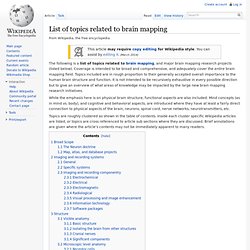

Neuroinformatics. Neuroinformatics is a research field concerned with the organization of neuroscience data by the application of computational models and analytical tools.

These areas of research are important for the integration and analysis of increasingly large-volume, high-dimensional, and fine-grain experimental data. Neuroinformaticians provide computational tools, mathematical models, and create interoperable databases for clinicians and research scientists. Neuroscience is a heterogeneous field, consisting of many and various sub-disciplines (e.g., Cognitive Psychology, Behavioral Neuroscience, and Behavioral Genetics).
In order for our understanding of the brain to continue to deepen, it is necessary that these sub-disciplines are able to share data and findings in a meaningful way; Neuroinformaticians facilitate this.[1] Mapping the human brain connectivity. List of neuroscience databases. A number of online neuroscience databases are available which provide information regarding gene expression, neurons, macroscopic brain structure, and neurological or psychiatric disorders.

While some databases contain descriptive and numerical data, others include postmortem brain sections or 3D MRI and fMRI images. A list that is regularly updated can be found at the Neuroscience Information Framework database list, which contains over 2500 databases relevant to neuroscience. Other databases[edit] See also[edit] List of topics related to brain mapping. The following is a list of topics related to brain mapping, and major brain mapping research projects (listed below).

Coverage is intended to be broad and comprehensive, and adequately cover the entire brain mapping field. Topics included are in rough proportion to their generally accepted overall importance to the human brain structure and function.